All about Hoysala Temples
I. Introduction
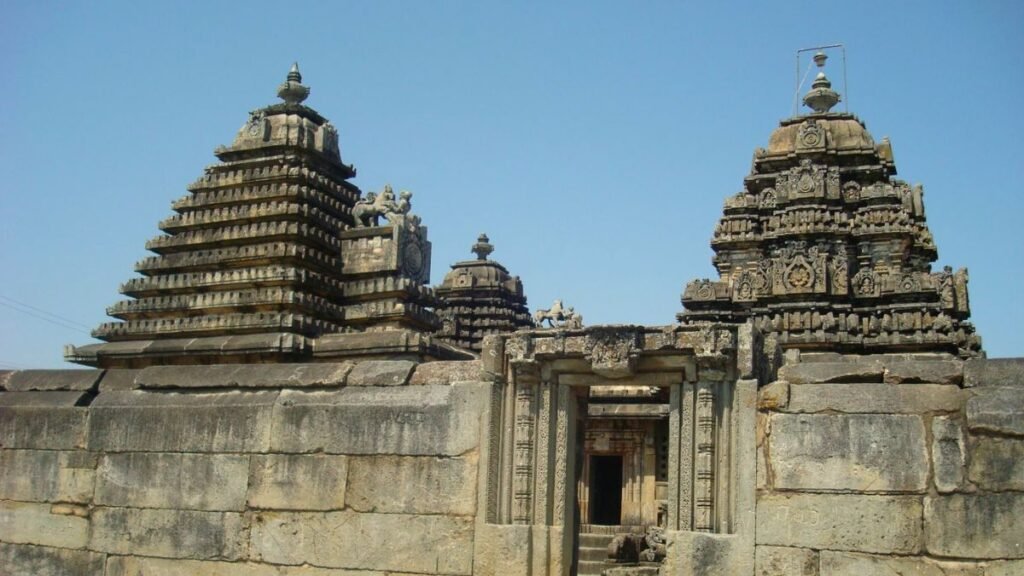
A. Brief overview of Hoysala architecture
Picture this: You’re standing in front of a temple that looks like it’s straight out of a fantasy movie. Every inch is covered in intricate carvings, telling stories from ancient myths. That’s Hoysala architecture for you – and trust me, it’s mind-blowing!
I first stumbled upon these incredible temples during a trip to Karnataka, and I’ve been hooked ever since. The Hoysala rulers built these beautiful Hoysala Temples between the 11th and 14th centuries, and boy, did they know how to make an impression!
Here’s a cool fact: Most of these temples are made from soapstone. It starts out soft and easy to carve, but hardens over time. Clever, right?
B. Mention of famous temples (Belur and Halebid)
Now, if you’ve heard of Hoysala temples before, you’re probably thinking of the big shots – Belur and Halebid. Don’t get me wrong, they’re stunning. I remember my jaw dropping when I first saw the Chennakesava Temple at Belur. And the Hoysaleswara Temple at Halebid? It’s like a history book carved in stone!
These places are usually crawling with tourists, and for good reason. But here’s the thing – they’re just the tip of the iceberg.
C. Teaser about the hidden gems to be explored
On my last trip, I decided to dig a little deeper. And boy, am I glad I did! Turns out, the area around Hassan is hiding some serious treasures. I’m talking about temples that are just as beautiful as the famous ones, but without the crowds.
Imagine having an entire ancient temple all to yourself. No selfie sticks in your way, no tour groups drowning out the peaceful atmosphere. Just you and centuries of incredible art and history. Sounds amazing, right?
Well, that’s exactly what I found. And I’m dying to share it with you! In this post, I’m going to take you on a journey to five hidden Hoysala temples that blew my mind. We’re talking about places where you can trace intricate carvings with your fingers (gently, of course!) and soak in the atmosphere of a bygone era in peace.
From a temple that’s one of the earliest examples of Hoysala architecture to another that looks like it has four shrines instead of one – each of these places has its own unique story. And the best part? You won’t find these in your average guidebook.
So, are you ready for an adventure off the beaten path? Strap in, because we’re about to uncover some of Karnataka’s best-kept secrets. Trust me, by the end of this, you’ll be itching to book your ticket to Hassan!
Absolutely! I’ll rewrite this section in a more engaging, personal style with simpler language and interesting facts. Here’s the revised version:
II. The Allure of Hoysala Architecture
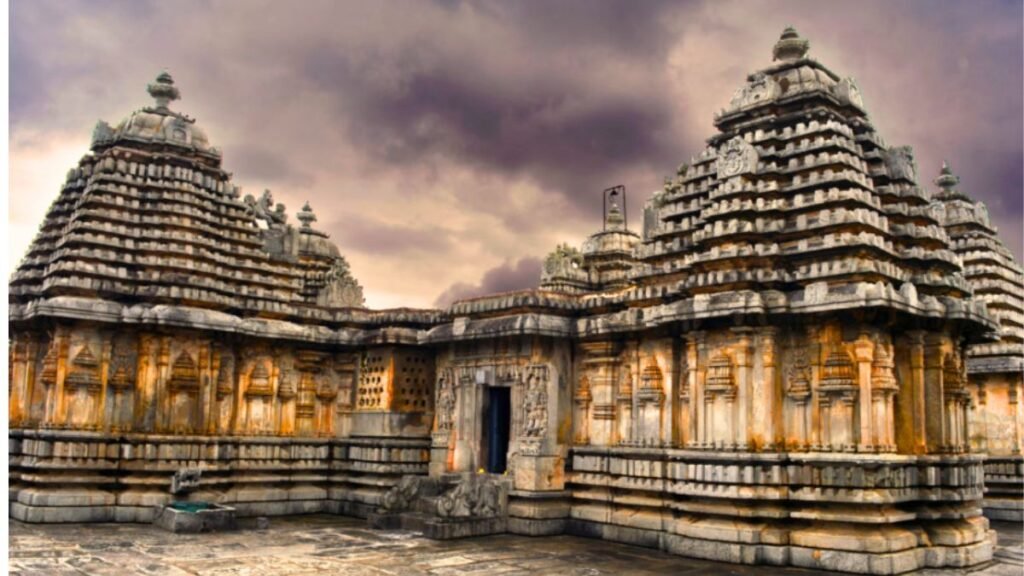
Let me tell you, there’s something magical about Hoysala architecture. It’s like stepping into a different world – one where every surface tells a story. Before we dive into our hidden gems, let’s chat about what makes these temples so special.
A. Distinctive features (star-shaped designs, intricate carvings)
First up, the shape. Most temples I’ve seen are pretty straightforward – square or rectangular. But Hoysala temples? They love to show off with their star-shaped designs. It’s like they’re reaching out in all directions, trying to touch the sky.
And the carvings? Oh boy. I’ve spent hours – literally, hours – just staring at a single wall. These artisans were next level. Every inch is covered in intricate details. Gods, goddesses, epic battles, everyday life scenes – it’s all there. I once counted over 50 unique hairstyles on the sculptures in one temple. Talk about fashion inspiration!
B. Building materials (soapstone)
Now, here’s a fun fact that blew my mind. Most of these temples are made from soapstone. Yep, the same stuff they use to make those little carved elephants you find in souvenir shops.
But here’s the cool part – when they quarried it, the stone was soft and easy to carve. Over time, it hardened into the durable structures we see today. Imagine that – temples that literally grew stronger with age. If that’s not a metaphor for something, I don’t know what is!
C. Common architectural elements (Jagati, Vimana, Mantapa)
Okay, I’m going to throw some fancy words at you, but stick with me – they’re actually pretty cool.
First, there’s the Jagati. It’s like a giant platform that the whole temple sits on. I love these because you can walk around the entire temple and see it from all angles. Plus, it’s a great spot for that perfect Instagram shot!
Then we’ve got the Vimana. That’s the tower over the inner sanctum where the deity hangs out. It’s usually covered in intricate carvings and looks like a wedding cake made of stone.
Finally, there’s the Mantapa. Think of it as the temple’s living room. It’s a pillared hall where people gather, and let me tell you, some of these pillars are works of art in themselves. I once saw one that was so finely carved, it looked like it was draped in stone fabric. Mind-boggling!
These elements come together to create temples that are more than just places of worship – they’re like giant puzzles, full of details waiting to be discovered. Every time I visit, I notice something new. It’s like the temples have secrets they’re slowly revealing, one visit at a time.
So, now that we’re all experts in Hoysala architecture (okay, maybe not experts, but at least enthusiastic admirers), are you ready to explore some hidden treasures? Trust me, what’s coming up next is going to knock your socks off!
Absolutely! I’ll write about the Lakshminarasimha Temple in Nuggehalli using a more personal, engaging style with simple language and interesting facts. Here’s the revised section:
III. Hidden Gem No.1: Lakshminarasimha Temple, Nuggehalli
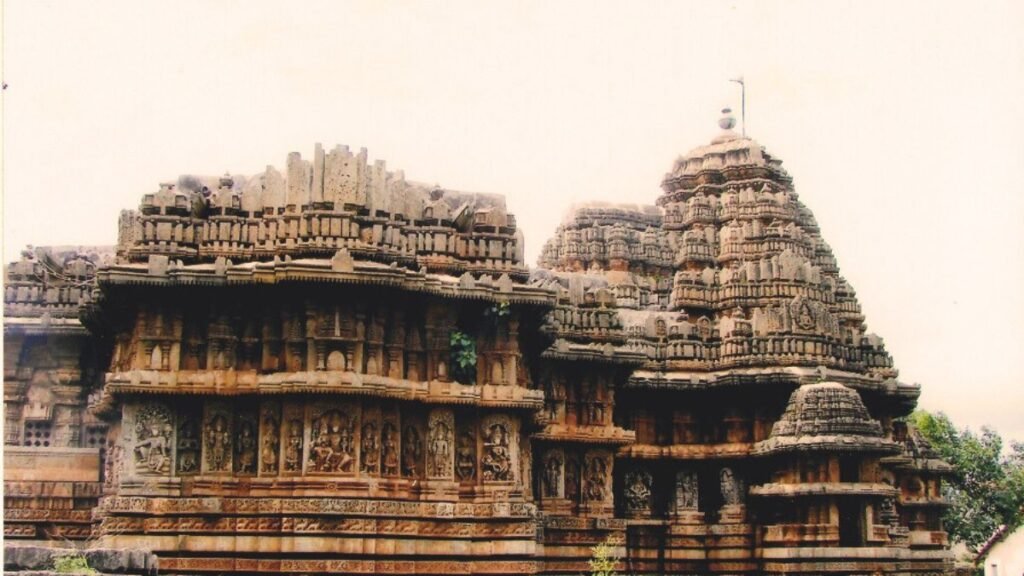
A. Location and how to get there
Alright, adventure seekers, our first stop is the Lakshminarasimha Temple in Nuggehalli. Now, don’t worry if you’ve never heard of Nuggehalli before – I hadn’t either until I stumbled upon this gem!
It’s about 50 km from Hassan, tucked away on the Tiptur-Channarayapatna highway. I’ll be honest, finding it was half the fun! I rented a scooter in Hassan (highly recommend for temple-hopping), but you can also grab a bus or taxi. For the scooter rental you can contact Bounce which is located near lawyers colony in Hassan.
Pro tip: Download an offline map before you go, because cell service can be spotty. The best place to download the offline map is our beloved Google!
B. Historical background (built in 1246 CE)
Get this: this temple has been standing here since 1246 CE. That’s almost 800 years! It was built during the reign of the Hoysala king Vira Someshwara. Imagine all the stories these walls could tell if they could talk!
Fun fact: the temple was built by a commander named Bommanna Dandanayaka. I like to think of him as the Hoysala version of a modern-day philanthropist, commissioning this masterpiece for the ages.
C. Architectural highlights (trikuta style, rich sculptures)
Now, let me tell you why this temple made me go “Wow!” First off, it’s built in what’s called a trikuta style. In simple terms, it means “three shrines.” It’s like getting three temples for the price of one!
But the real showstoppers are the sculptures. Every inch of the outer walls is covered in intricate carvings. I spent hours just walking around the temple, finding new details each time. There are stories from Hindu epics, celestial beings, and geometric patterns that’ll make your head spin.
My favorite part? The lathe-turned pillars inside. They’re so perfectly round and smooth, it’s hard to believe they were made without modern tools. I kept running my hands over them (respectfully, of course), marveling at the craftsmanship.
D. Nearby Sadasiva Temple (Ekakuta style)
Just when I thought I’d seen it all, I discovered there’s another temple right next door! The Sadasiva Temple, built in 1249 CE by a fearless commander of the Hoysala Empire known as Bommanna Dandanayaka, is a completely different style. It’s what they call ekakuta, meaning it has just one shrine or also where in you combine together to form it as one.
What’s cool about this one is how different it looks from its neighbor. While the Lakshminarasimha Temple is all about the bling, the Sadasiva Temple is more… let’s say, strong and silent. It doesn’t have all the fancy sculptures outside, but there’s something really powerful about its simplicity.
I ended up spending way more time in Nuggehalli than I planned, but it was totally worth it. These two temples side by side really show you the range of Hoysala architecture. Plus, having them all to myself (except for a few friendly locals) was an experience I’ll never forget.
So, if you’re up for a little adventure and want to see some amazing Hoysala temples without the crowds, put Nuggehalli on your list. Trust me, you won’t regret it!
Absolutely! I’ll write this section in a more personal, engaging style with simpler language and interesting facts. Here’s the revised version:
IV. Hidden Gem No.2: Lakshmi Devi Temple, Doddagaddavalli
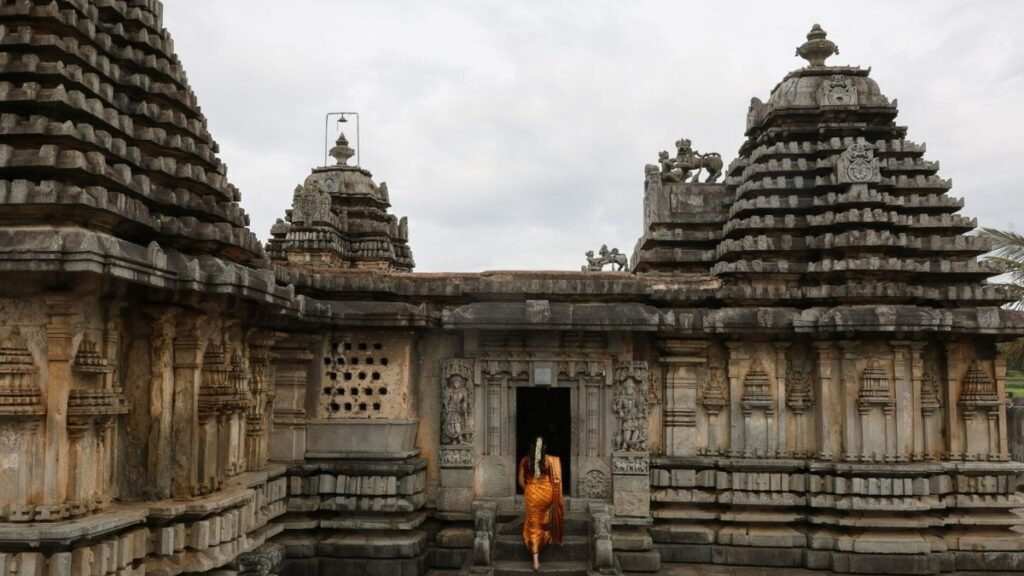
A. Location and accessibility
Alright, adventurers, let’s talk about finding this hidden beauty! The Lakshmi Devi Temple is tucked away in the tiny village of Doddagaddavalli. It’s about a 16 km drive from Hassan, and trust me, it’s worth every bump in the road.
I’ll be honest, I almost missed the turn-off. Pro tip: keep your eyes peeled for a small sign pointing down a narrow lane. It feels like you’re heading into someone’s backyard, but that’s part of the charm!
B. Historical significance (one of the earliest Hoysala temples, 1114 CE)
Now, here’s where it gets really cool. This temple is like the great-grandparent of all the Hoysala temples we know and love. Built way back in 1114 CE, it’s one of the earliest examples of Hoysala architecture still standing.
Imagine this: when this temple was being built, the Hoysala style was just taking shape. It’s like seeing the first draft of a masterpiece! I couldn’t help but run my hands over the walls, thinking about the artisans who worked here over 900 years ago. It’s like touching history!
C. Unique features (Chatuskuta design, absence of Jagati)
Okay, bear with me while I geek out for a second. This temple is special because it’s a ‘chatuskuta’ – that means it has four shrines instead of the usual one or three. It’s like the Hoysala architects were experimenting, trying out new ideas.
And here’s another quirky thing – there’s no ‘jagati’ (that’s a raised platform most Hoysala temples sit on). Without it, you feel even closer to the temple. I literally had to crane my neck to see the top!
Inside, it’s like a treasure hunt. I spent hours looking for hidden carvings and unique details. My favorite find? A carving of Saraswati, the goddess of knowledge, hidden away in a corner. It felt like she was winking at me!
D. Natural surroundings (coconut plantations, lake)
But it’s not just the temple that’s breathtaking. The setting is straight out of a postcard! The temple is surrounded by swaying coconut palms, and there’s a serene lake just behind it.
I timed my visit for sunset, and let me tell you, it was magical. The golden light hitting the temple, reflecting off the lake… I must have taken a hundred photos, but none of them do it justice.
Here’s a fun fact: Locals of the area believe the lake( Hunasinakere lake) is home to a giant fish that’s as old as the temple itself. I didn’t see it (maybe next time?), but I love how these old places are always wrapped in fascinating stories.
As I sat by the lake, watching the sun go down, I couldn’t help but feel lucky. Here I was, at this incredible ancient temple, with not another tourist in sight. Just me, the temple, and centuries of history. It’s moments like these that make all the wrong turns and bumpy roads worth it.
So, if you’re up for a little adventure and a lot of wonder, put the Lakshmi Devi Temple on your must-visit list. Just don’t tell too many people about it – let’s keep this hidden gem our little secret, shall we?
Absolutely! I’ll craft a more engaging, personal account for the Bucesvara Temple section using simpler language, interesting facts, and a first-person perspective. Here’s the revised version:
V. Hidden Gem No.3: Bucesvara Temple, Koravangala
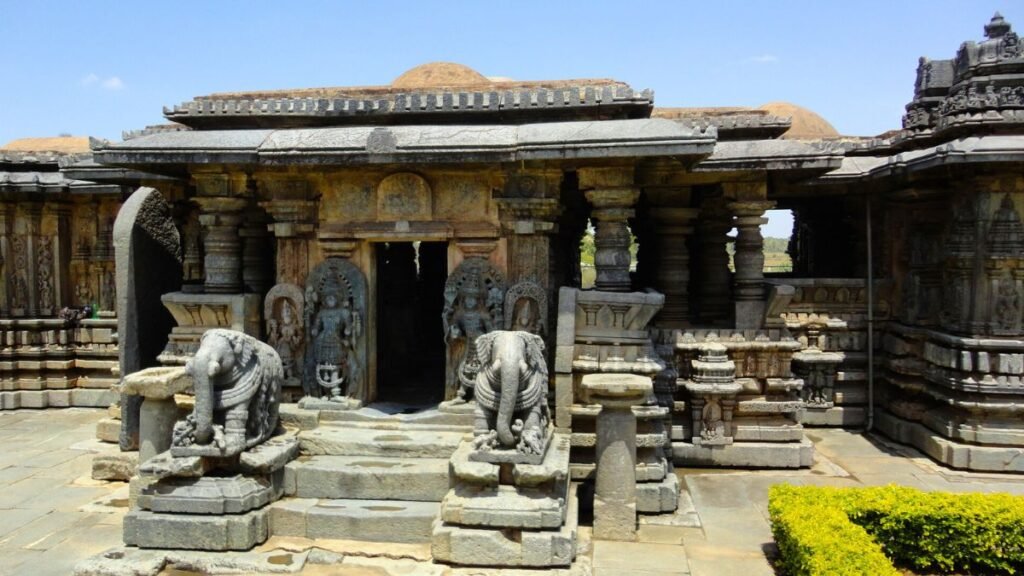
A. Location details
Alright, adventure seekers, let’s talk about my favorite find on this Hoysala treasure hunt – the Bucesvara Temple in Koravangala. Getting there is half the fun! It’s tucked away about 10 km from Hassan, and trust me, the drive is gorgeous. Picture winding roads through lush green fields and tiny villages. Pro tip: I used my phone’s GPS, but it got a bit confused near the end. Just ask a local for “Buchesvara Temple” (that’s how they pronounce it), and they’ll point you right to it.
B. Historical context (built in 1173 AD)
Now, here’s where it gets really cool. This temple has been standing here since 1173 AD. That’s over 800 years! Imagine all the stories these walls could tell if they could talk.
Here’s a fun fact I learned from a local guide: The temple wasn’t built by a king, but by a wealthy officer named Buci. Apparently, he was so pumped about the coronation of Hoysala King Veera Ballala II that he decided to build this entire temple to celebrate. Talk about a grand gesture!
C. Architectural uniqueness (Dvikuta design)
When I first saw the Bucesvara Temple, I thought I was seeing double. Turns out, I kind of was! This temple has what’s called a “dvikuta” design. In simple terms, it means there are two shrines facing each other. It’s like the temple has a twin!
What’s really neat is how these shrines are connected. There’s a closed hall (mantapa) and an open hall linking them. I spent ages just walking between the two, marveling at how the light plays differently in each space.
D. Noteworthy decorative features
Now, let’s talk about the eye candy. The decorations here are what the experts call “old kind” – the style that was popular even before the Hoysalas came along. But don’t let that fool you; these carvings are anything but basic.
I was blown away by the details on the outer walls. There are intricate geometric patterns, mythological scenes, and some figures that made me reach for my camera every few steps. One of my favorite spots was near the entrance. There’s this amazing panel showing scenes from the Ramayana. I’m no expert, but even I could recognize Hanuman carrying the mountain!
Inside, keep an eye out for the beautifully carved pillars. Each one is like a work of art. I caught myself wondering how long it must have taken to carve each tiny detail.
Oh, and here’s a little secret: There are two more temples nearby that are in ruins. They’re not as well-preserved as Bucesvara, but they add a kind of mysterious, Indiana Jones vibe to the whole place.
By the time I left Bucesvara Temple, my camera was full, and my mind was blown. This place might not be as famous as some other Hoysala temples, but in my book, it’s an absolute must-visit. It’s like stepping into a time machine, minus the crowds. Just you, centuries of history, and some of the most incredible stone carving you’ll ever see. Trust me, it’s worth every bit of the journey to get here!
Absolutely! I’ll write about the Nageshvara-Chennakeshava Temple Complex in Mosale using a more personal, engaging style with simple language and interesting facts. Here’s the section for your blog post:
VI. Hidden Gem No.4: Nageshvara-Chennakeshava Temple Complex, Mosale
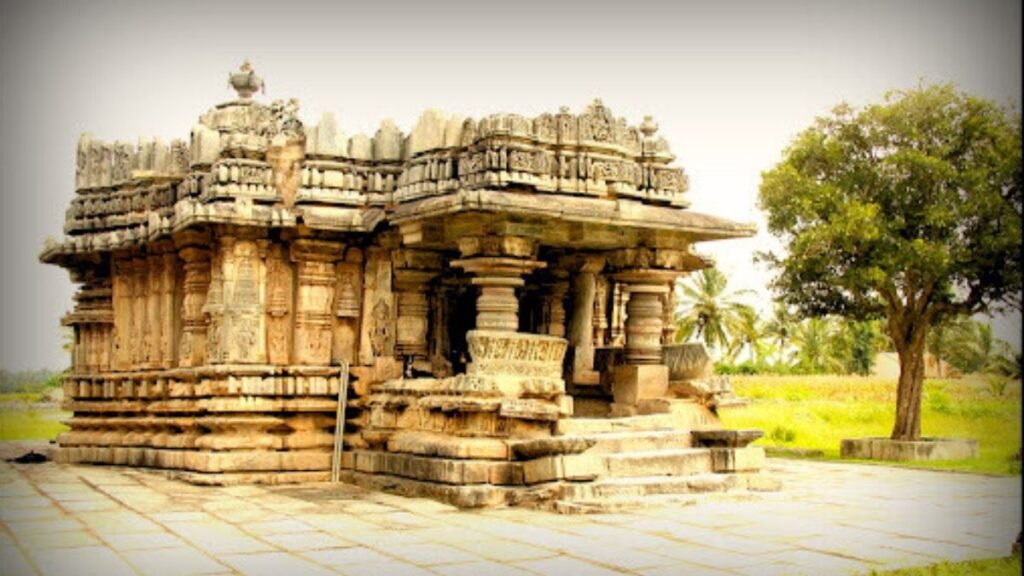
Okay, folks, buckle up because we’re heading to my personal favorite on this list – the Nageshvara-Chennakeshava Temple Complex in Mosale. Trust me, this place is a real treat!
A. Location and distance from Hassan
First things first – how to get there. Mosale is a tiny village that’s just a short 13 km hop from Hassan. I remember thinking, “How come I’ve never heard of this place before?” as I navigated the winding roads. Pro tip: rent a scooter in Hassan for a fun ride through the countryside. Just follow the Belur road and keep an eye out for the signs to Mosale. It’s an easy day trip, and the journey itself is half the fun!
B. Historical background (built in 1200 AD)
Now, let’s time-travel back to 1200 AD. That’s when this stunning complex was built, during the reign of the Hoysala king Veera Ballala II. Imagine – these temples have been standing here for over 800 years! I don’t know about you, but that blows my mind. As I walked around, I couldn’t help but wonder about all the people who’ve stood in this same spot over the centuries.
C. Architectural style (Ekakuta design)
Here’s where it gets really interesting. The complex has two main temples, and they’re both what’s called ‘ekakuta’ style. In simple terms, that means each temple has a single shrine with a tower on top. But don’t let that fool you – these aren’t simple structures by any means!
D. Distinctive Hoysala features present
Remember those signature Hoysala features I mentioned earlier? Well, this place is like a checklist of Hoysala architecture greatest hits!
First off, there’s the star-shaped base. I spent a good ten minutes just walking around the outside, admiring how the walls seem to dance in and out. Then there are the intricate carvings – oh boy, the carvings! Every inch of the outer walls is covered in detailed sculptures. I’m talking gods, goddesses, animals, and geometric patterns. Bring a good camera (or just use your phone) because you’ll want to zoom in on these details.
Inside, you’ll find the classic Hoysala-style lathe-turned pillars. They’re so perfectly round and smooth, it’s hard to believe they were made without modern tools. I remember running my hand over one (gently, of course) and marveling at the craftsmanship.
But my favorite part? The ceiling. Look up when you’re inside, and you’ll see the most beautiful, intricate designs. In the center of the main hall, there’s this amazing pendant-like structure hanging from the ceiling. It’s called a ‘sukhanasi’, and it’s a hallmark of Hoysala temples.
As I was leaving, I noticed something that made me chuckle – there’s a small carving of a couple in a, let’s say, ‘intimate’ pose. These Hoysala sculptors had a cheeky sense of humor!
I spent hours exploring this complex, and honestly, I could have stayed longer. There’s something magical about standing in a place with so much history, especially when you have it all to yourself. If you visit only one temple from this list, make it this one. Just don’t forget to bring water and snacks – there isn’t much around in terms of facilities!
Absolutely! I’ll rewrite this section in a more personal, engaging style with simple language and some interesting tidbits. Here’s the revised version:
VIII. Tips for Exploring Hidden Hoysala Temples
Alright, fellow temple explorers! Before you rush off to discover these hidden gems, let me share some insider tips I’ve picked up on my adventures. Trust me, these will make your trip so much smoother!
A. Best time to visit
Here’s the scoop: Karnataka can get pretty toasty! I made the mistake of visiting in May once, and whew, it was like walking into an oven. Learn from my sweat-drenched experience – the best time to visit is between October and February.
Pro tip: I love going in January. The weather’s perfect for temple hopping, and you might catch some local harvest festivals. Double win!
B. Transportation options
Now, let’s talk about getting around. Public transport to these hidden temples can be… let’s say, an adventure in itself. On my first trip, I waited for a bus that never came. Oops!
Here’s what I do now: I rent a car or a motorbike in Hassan. It’s not too expensive, and the freedom is awesome. Plus, the roads to these temples are like a beautiful bonus tour of rural Karnataka. Just make sure you’ve got Google Maps – the signage isn’t always great.
C. Photography tips
Calling all Instagram enthusiasts and photography buffs! These temples are a photographer’s dream, but they can be tricky to capture. Here’s what I’ve learned:
- Early bird gets the worm (and the best light). I start my day at sunrise – the soft morning light makes those carvings pop!
- Bring a wide-angle lens if you can. You’ll want to capture those full temple views.
- Don’t forget to zoom in on the details. Some of the tiny carvings blew my mind!
- Patience is key. I once waited 20 minutes for the perfect shot without other visitors. Worth it!
D. Respectful tourism practices
Okay, serious talk time. These temples aren’t just pretty photo ops – they’re important historical and religious sites. Let’s keep them awesome for future explorers, shall we?
- Dress modestly. I always pack a scarf to cover my shoulders, just in case.
- Take off your shoes before entering. Pro tip: bring socks if you don’t want dirty feet!
- Ask before taking photos of people, especially during worship.
- Don’t climb on anything. I know it’s tempting for that perfect selfie, but let’s preserve these beauties.
- Keep your voice down. The peaceful atmosphere is part of the magic!
Oh, and here’s something cool I learned: in some temples, if you clap in front of the pillars, they make different musical notes. But ask a guide before trying it – not all temples allow this.
Remember, folks: we’re guests here. Let’s be the kind of tourists we’d want visiting our own special places!
Follow these tips, and I promise you’ll have an amazing, respectful, and totally Insta-worthy adventure exploring these hidden Hoysala temples.
Absolutely! I’ll rewrite the conclusion in a more personal, engaging style with simpler language and interesting facts. Here’s a revised version for the conclusion:
IX. Conclusion
A. Recap of the hidden gems explored
Wow, what a journey we’ve been on! Can you believe all these incredible temples were just hiding in plain sight? From the moment I stepped into the Lakshminarasimha Temple in Nuggehalli, with its three towers reaching for the sky, I knew I was in for something special. But each stop on our little adventure brought its own surprises.
Remember the Lakshmi Devi Temple in Doddagaddavalli? That lake view is something I won’t forget in a hurry. And the Bucesvara Temple in Koravangala – who knew a 850-year-old building could still look so good? The Nageshvara-Chennakeshava Temple complex in Mosale felt like stepping into a time machine. And that Lakshminarasimha Temple in Javagal? Talk about saving the best for last!
B. Importance of preserving these lesser-known sites
Here’s the thing, though. While I was blown away by these temples, I also felt a little sad. Some of them are showing their age, and without proper care, we might lose these treasures. It’s not just about pretty buildings – these temples are like history books written in stone. They tell us so much about the people who lived here centuries ago, how they thought, what they believed in.
I met this lovely old man near one of the temples. He told me stories his grandfather had told him about the place. It made me realize – these temples aren’t just tourist spots. They’re a living part of the local culture. If we lose them, we lose all of that too.
C. Encouragement for readers to explore off-the-beaten-path destinations
So, here’s my challenge to you: Next time you’re planning a trip, don’t just stick to the famous spots. Sure, places like Belur and Halebid are amazing and you should definitely see them. But why stop there?
There’s something magical about discovering a place that feels like it’s your own secret. Trust me, standing alone in a centuries-old temple, with no other tourists around, is an experience you won’t forget. Plus, you’ll be supporting local communities that don’t usually see many visitors.
Who knows? Maybe you’ll stumble upon a hidden gem I haven’t even found yet! And if you do, promise you’ll come back and tell me all about it, okay?
Remember, travel isn’t just about ticking boxes on a list of famous sites. It’s about the stories you collect, the surprises you encounter, and the secrets you uncover. So go on, be a history detective. Karnataka is waiting for you to explore its hidden treasures. I promise you won’t regret it!
And hey, if you end up visiting any of these temples, drop me a line. I’d love to hear about your adventure. Happy travels, folks!
Absolutely! I’ll rewrite the practical information section in a more personal, engaging style with simpler language and interesting tidbits. Here’s the revised version:
X. Practical Information
A. Accommodation options in Hassan
Alright, let’s talk about where to crash after a long day of temple-hopping! Hassan’s got a mix of places to suit different budgets. During my trips, I’ve tried a few options.
If you’re looking to splurge a bit, the Hoysala Village Resort is pretty sweet. It’s got this cool Hoysala-inspired architecture that’ll keep you in the temple mood. But my personal favorite? A homestay I found just outside the city. The family was super friendly, and their homemade breakfast was to die for!
Pro tip: Book in advance if you’re visiting during peak season (October to February). Trust me, you don’t want to end up sleeping in your car like I almost did on my first trip!
B. Local cuisine to try
Okay, foodies, listen up! Karnataka cuisine is seriously underrated, and Hassan’s got some gems. You’ve got to try the Bisi Bele Bath – it’s this spicy, rice-based dish that’ll warm you right up.
But the absolute must-try? Ragi Mudde. It’s this ball made of millet that locals eat with spicy curries. I’ll be honest, it took me a couple of tries to get used to it, but now I’m hooked!
Oh, and don’t leave without trying the local coffee. This region grows some amazing beans, and the filter coffee here is like a hug in a cup.
C. Other nearby attractions
While the temples are the stars of the show, there’s plenty more to see around Hassan. If you’re into wildlife, Bhadra Wildlife Sanctuary is just a couple of hours away. I saw my first wild elephant there – talk about an adrenaline rush!
For a change of pace, check out the Shettihalli Rosary Church. It’s this half-submerged church that looks straight out of a movie set. I caught it at sunset once, and let me tell you, it was Instagram gold!
D. Useful contacts (local tourism office, guides)
Now, I’m all for independent exploration, but sometimes local expertise can really enhance your experience. The District Tourism Office in Hassan (+91 8172 268862) is super helpful. They pointed me towards some real hidden gems on my last trip.
For Bike Rentals you can contact Bounce, which is located at Lokesh Xerox centre, Coart Complex, near law association, RC Road, Hassan and their telephone no is +918061915352.
Oh, and don’t forget to download the Karnataka Tourism app. It’s got some decent info and can be a lifesaver when you’re out in the villages with patchy internet.
Remember, half the fun is in the adventure of getting there and figuring things out. So don’t stress too much if things don’t go exactly to plan. Some of my best memories are from when I got completely lost and ended up having chai with a local family!
Happy exploring, folks! If you discover any cool spots or tips, drop them in the comments. Let’s help each other make the most of this amazing region!

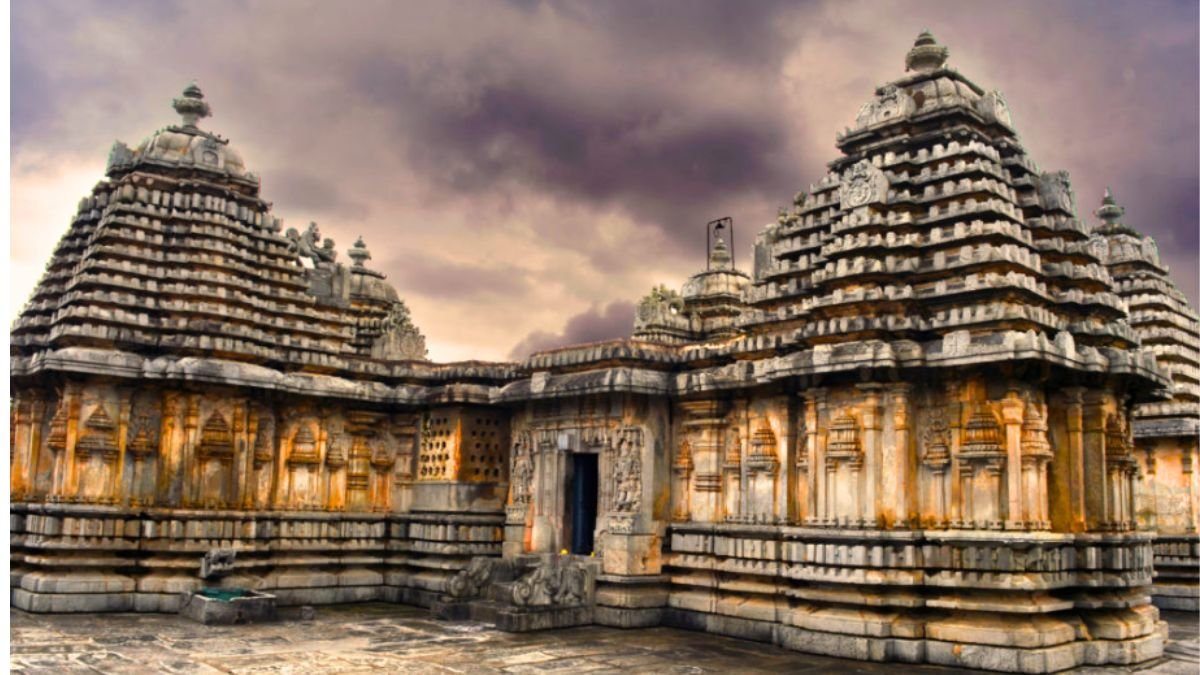
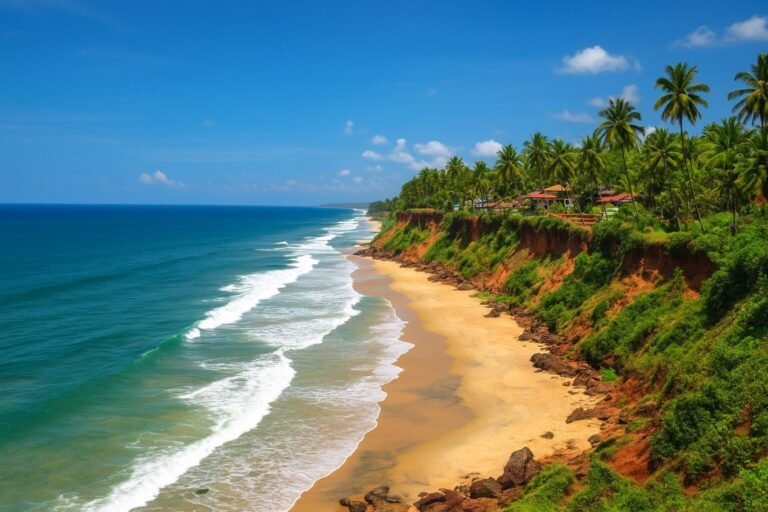
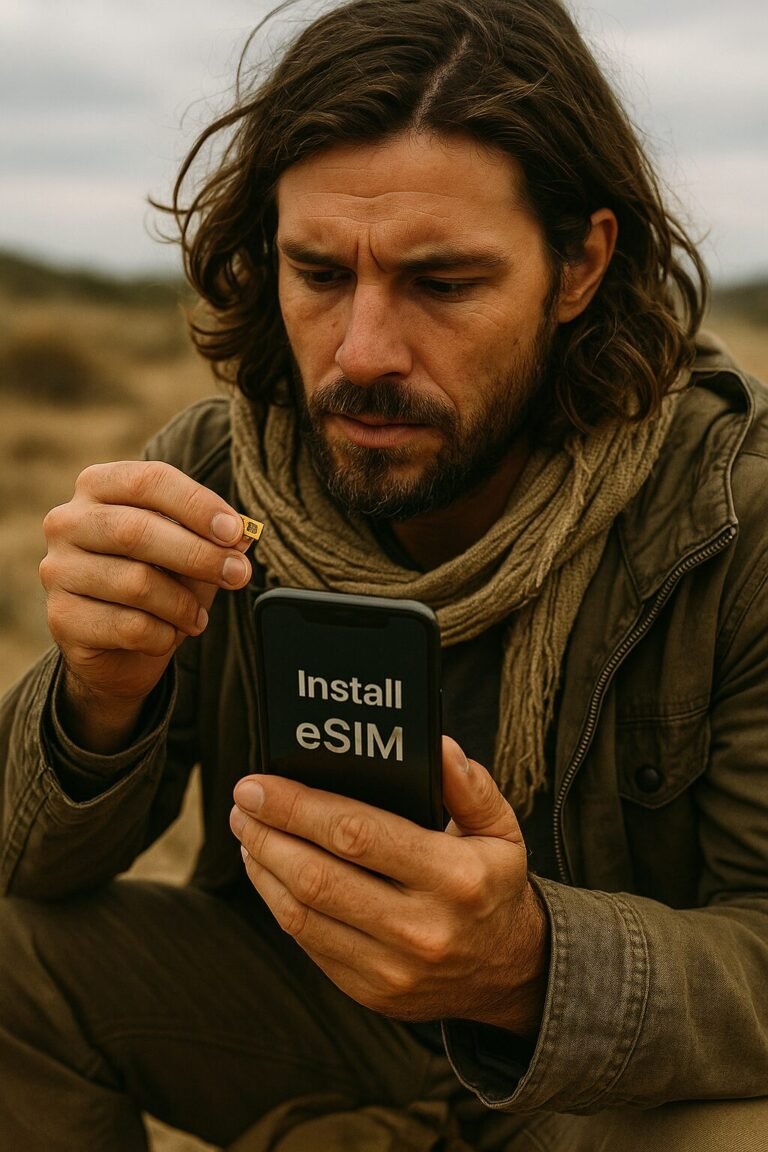

Thanks for sharing. I read many of your blog posts, cool, your blog is very good.
It’s actually a great and useful piece of information. I’m happy that you simply shared this helpful information with us. Please stay us up to date like this. Thank you for sharing.
Can you be more specific about the content of your article? After reading it, I still have some doubts. Hope you can help me. https://accounts.binance.com/hu/register?ref=FIHEGIZ8
I like this web site so much, saved to favorites.
Thank you for your sharing. I am worried that I lack creative ideas. It is your article that makes me full of hope. Thank you. But, I have a question, can you help me?
Thank you for your sharing. I am worried that I lack creative ideas. It is your article that makes me full of hope. Thank you. But, I have a question, can you help me? https://www.binance.com/join?ref=P9L9FQKY
My husband and i felt now joyful when John could complete his research by way of the ideas he came across through the web page. It’s not at all simplistic just to always be giving out guidance which often men and women might have been making money from. And we all understand we have the blog owner to be grateful to for this. Those explanations you made, the straightforward site navigation, the friendships you make it possible to foster – it’s many incredible, and it’s really leading our son and our family feel that the theme is exciting, and that is really important. Many thanks for everything!
I admire your work, thanks for all the useful articles.
Today, I went to the beach front with my children. I found a sea shell and gave it to my 4 year old daughter and said “You can hear the ocean if you put this to your ear.” She put the shell to her ear and screamed. There was a hermit crab inside and it pinched her ear. She never wants to go back! LoL I know this is completely off topic but I had to tell someone!
Do you have a spam problem on this site; I also am a blogger, and I was wondering your situation; we have created some nice procedures and we are looking to swap strategies with other folks, why not shoot me an e-mail if interested.
I am always browsing online for ideas that can assist me. Thank you!
hi!,I like your writing so much! share we keep in touch more approximately your article on AOL? I need a specialist on this house to resolve my problem. Maybe that’s you! Looking forward to see you.
Thanks for your helpful post. Through the years, I have come to be able to understand that the symptoms of mesothelioma cancer are caused by the actual build up connected fluid between the lining of your lung and the torso cavity. The disease may start inside chest vicinity and multiply to other body parts. Other symptoms of pleural mesothelioma cancer include fat reduction, severe deep breathing trouble, a fever, difficulty swallowing, and inflammation of the neck and face areas. It ought to be noted that some people with the disease will not experience virtually any serious symptoms at all.
Your article helped me a lot, is there any more related content? Thanks! https://www.binance.com/cs/join?ref=S5H7X3LP
You should take part in a contest for among the best blogs on the web. I’ll advocate this web site!
Thanks for your recommendations on this blog. One thing I wish to say is purchasing electronics items on the Internet is not new. In reality, in the past several years alone, the market for online electronics has grown drastically. Today, you’ll find practically any specific electronic system and gizmo on the Internet, from cameras along with camcorders to computer elements and games consoles.
affordablecanvaspaintings.com.au is Australia Popular Online 100 percent Handmade Art Store. We deliver Budget Handmade Canvas Paintings, Abstract Art, Oil Paintings, Artwork Sale, Acrylic Wall Art Paintings, Custom Art, Oil Portraits, Pet Paintings, Building Paintings etc. 1000+ Designs To Choose From, Highly Experienced Artists team, Up-to 50 percent OFF SALE and FREE Delivery Australia, Sydney, Melbourne, Brisbane, Adelaide, Hobart and all regional areas. We ship worldwide international locations. Order Online Your Handmade Art Today.
Hello there, I discovered your site by way of Google at the same time as searching for a similar matter, your site came up, it seems good. I’ve bookmarked it in my google bookmarks.
This web page does not display properly on my iphone 4 – you might want to try and fix that
Thank you for your sharing. I am worried that I lack creative ideas. It is your article that makes me full of hope. Thank you. But, I have a question, can you help me?
Hello there! This post could not be written any better! Reading this post reminds me of my old room mate! He always kept chatting about this. I will forward this article to him. Pretty sure he will have a good read. Thanks for sharing!
One thing I’ve noticed is the fact that there are plenty of common myths regarding the banking institutions intentions if talking about property foreclosure. One fantasy in particular is the fact the bank prefers to have your house. The bank wants your hard earned dollars, not the house. They want the money they loaned you together with interest. Staying away from the bank will only draw any foreclosed final result. Thanks for your posting.
I really appreciate this post. I?¦ve been looking all over for this! Thank goodness I found it on Bing. You have made my day! Thx again
I’m in awe of the author’s ability to make complicated concepts accessible to readers of all backgrounds. This article is a testament to her expertise and dedication to providing useful insights. Thank you, author, for creating such an engaging and enlightening piece. It has been an incredible joy to read!
hi!,I like your writing so much! share we communicate more about your article on AOL? I need a specialist on this area to solve my problem. May be that’s you! Looking forward to see you.
Magnificent website. Lots of useful information here. I am sending it to a few pals ans also sharing in delicious. And naturally, thanks for your sweat!
I don?t even know the way I stopped up here, but I assumed this submit was once great. I do not realize who you might be but certainly you’re going to a well-known blogger should you aren’t already 😉 Cheers!
This is a fantastic site, would you be interested in doing an interview about just how you designed it? If so e-mail me!
Your point of view caught my eye and was very interesting. Thanks. I have a question for you.
Would you be desirous about exchanging hyperlinks?
Hello, I think your site might be having browser compatibility issues. When I look at your blog site in Safari, it looks fine but when opening in Internet Explorer, it has some overlapping. I just wanted to give you a quick heads up! Other then that, excellent blog!
Your point of view caught my eye and was very interesting. Thanks. I have a question for you.
This is the correct weblog for anyone who desires to seek out out about this topic. You notice a lot its nearly hard to argue with you (not that I truly would want?HaHa). You definitely put a new spin on a topic thats been written about for years. Nice stuff, simply great!
I?ve recently started a site, the info you offer on this website has helped me greatly. Thanks for all of your time & work.
Thank you for your sharing. I am worried that I lack creative ideas. It is your article that makes me full of hope. Thank you. But, I have a question, can you help me?
Hi there! This is my first visit to your blog! We are a team of volunteers and starting a new initiative in a community in the same niche. Your blog provided us useful information to work on. You have done a marvellous job!
Hi there, I found your web site via Google while looking for a related topic, your site came up, it looks good. I’ve bookmarked it in my google bookmarks.
Someone essentially help to make seriously articles I would state. This is the first time I frequented your website page and thus far? I surprised with the research you made to create this particular publish extraordinary. Fantastic job!
My programmer is trying to persuade me to move to .net from PHP. I have always disliked the idea because of the costs. But he’s tryiong none the less. I’ve been using WordPress on a variety of websites for about a year and am concerned about switching to another platform. I have heard good things about blogengine.net. Is there a way I can import all my wordpress content into it? Any kind of help would be really appreciated!
You are my inhalation, I have few web logs and occasionally run out from brand :). “No opera plot can be sensible, for people do not sing when they are feeling sensible.” by W. H. Auden.
I have been browsing online more than 3 hours today, yet I never found any interesting article like yours. It is pretty worth enough for me. Personally, if all web owners and bloggers made good content as you did, the net will be much more useful than ever before.
Do you mind if I quote a couple of your articles as long as I provide credit and sources back to your webpage? My website is in the very same area of interest as yours and my visitors would really benefit from some of the information you provide here. Please let me know if this alright with you. Thank you!
Hi , I do believe this is an excellent blog. I stumbled upon it on Yahoo , i will come back once again. Money and freedom is the best way to change, may you be rich and help other people.
Your point of view caught my eye and was very interesting. Thanks. I have a question for you. https://www.binance.info/register?ref=IHJUI7TF
I always was interested in this topic and still am, thanks for putting up.
Thanks for this article. I might also like to talk about the fact that it can always be hard if you are in school and starting out to establish a long credit score. There are many students who are only trying to make it and have a protracted or positive credit history can be a difficult element to have.
You can definitely see your skills in the work you write. The world hopes for even more passionate writers like you who aren’t afraid to say how they believe. Always follow your heart.
Excellent blog here! Also your site quite a bit up very fast! What web host are you using? Can I get your associate link for your host? I want my website loaded up as fast as yours lol
Thanks for these guidelines. One thing I additionally believe is credit cards supplying a 0 interest rate often entice consumers with zero interest rate, instant authorization and easy online balance transfers, however beware of the number one factor that will certainly void your 0 easy streets annual percentage rate as well as throw anybody out into the bad house quickly.
As I website possessor I believe the content matter here is rattling wonderful , appreciate it for your efforts. You should keep it up forever! Good Luck.
I love what you guys are usually up too. Such clever work and exposure! Keep up the good works guys I’ve added you guys to our blogroll.
I can’t express how much I value the effort the author has put into producing this exceptional piece of content. The clarity of the writing, the depth of analysis, and the plethora of information provided are simply remarkable. Her zeal for the subject is evident, and it has undoubtedly made an impact with me. Thank you, author, for offering your wisdom and enlightening our lives with this extraordinary article!
Nice post. I be taught one thing tougher on completely different blogs everyday. It would all the time be stimulating to learn content from other writers and follow slightly something from their store. I?d want to use some with the content on my blog whether or not you don?t mind. Natually I?ll provide you with a link on your internet blog. Thanks for sharing.
Thanks for discussing your ideas. A very important factor is that pupils have an option between federal government student loan plus a private education loan where it really is easier to decide on student loan debt consolidation than over the federal student loan.
You made some good points there. I looked on the internet for the issue and found most individuals will consent with your website.
Hi there, You’ve done a great job. I will definitely digg it and personally suggest to my friends. I am confident they’ll be benefited from this web site.
This platform exceeded my expectations with scalable features and trustworthy service.
I’ve been active for almost a year, mostly for using the API, and it’s always quick deposits.
An interesting discussion is worth comment. I believe that it is best to write more on this topic, it might not be a taboo topic however generally people are not enough to talk on such topics. To the next. Cheers
I personally find that this platform exceeded my expectations with reliable uptime and accurate charts. The updates are frequent and clear.
The trading tools are clear transparency and stable performance.
Robin here — I’ve tried testing new tokens and the useful analytics impressed me.
The best choice I made for fiat on-ramp. Smooth and low fees.
Skyler here — I’ve tried providing liquidity and the intuitive UI impressed me.
The swapping tokens tools are great support and clear transparency.
Hi there, You have done an excellent job. I will certainly digg it and individually recommend to my friends. I’m confident they’ll be benefited from this website.
You have brought up a very excellent points, appreciate it for the post.
I don’t think the title of your article matches the content lol. Just kidding, mainly because I had some doubts after reading the article.
SpookySwap yieldI personally find that the interface is reliable uptime, and I enjoy checking analytics here.
SpookySwap
Great site, i recommend it to everyone ArbSwap
Wow that was unusual. I just wrote an really long comment but after I clicked submit my comment didn’t show up. Grrrr… well I’m not writing all that over again. Anyways, just wanted to say fantastic blog!
Yo, pakjeto has some cool stuff going on. I use it sometimes, when I’m bored and there’s nothing on Tv. Could be better but it’s got potential, ya feel me? pakjeto
Anyone else betting on BetMadrid games this week? I have a feeling they’re going to crush it! Let’s see. Follow them at betmadrid for all the action!
I truly appreciate this post. I have been looking all over for this! Thank goodness I found it on Bing. You have made my day! Thx again
It is perfect time to make a few plans for the future and it is time to be happy. I’ve read this submit and if I may just I want to recommend you some interesting issues or advice. Perhaps you could write next articles regarding this article. I desire to read more things approximately it!
Have you ever thought about adding a little bit more than just your articles? I mean, what you say is fundamental and all. Nevertheless think about if you added some great graphics or video clips to give your posts more, “pop”! Your content is excellent but with pics and clips, this website could definitely be one of the most beneficial in its field. Terrific blog!
Have you ever considered about including a little bit more than just your articles? I mean, what you say is fundamental and all. However imagine if you added some great pictures or videos to give your posts more, “pop”! Your content is excellent but with images and videos, this blog could definitely be one of the greatest in its niche. Awesome blog!